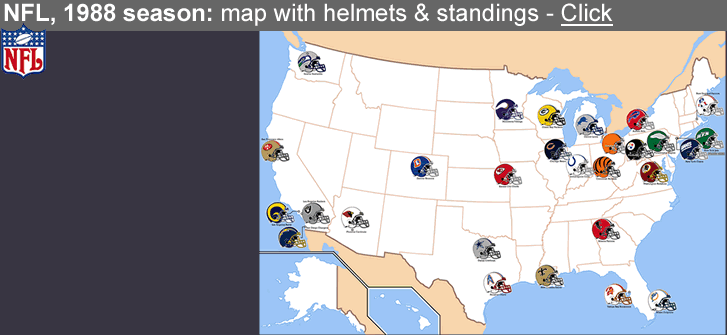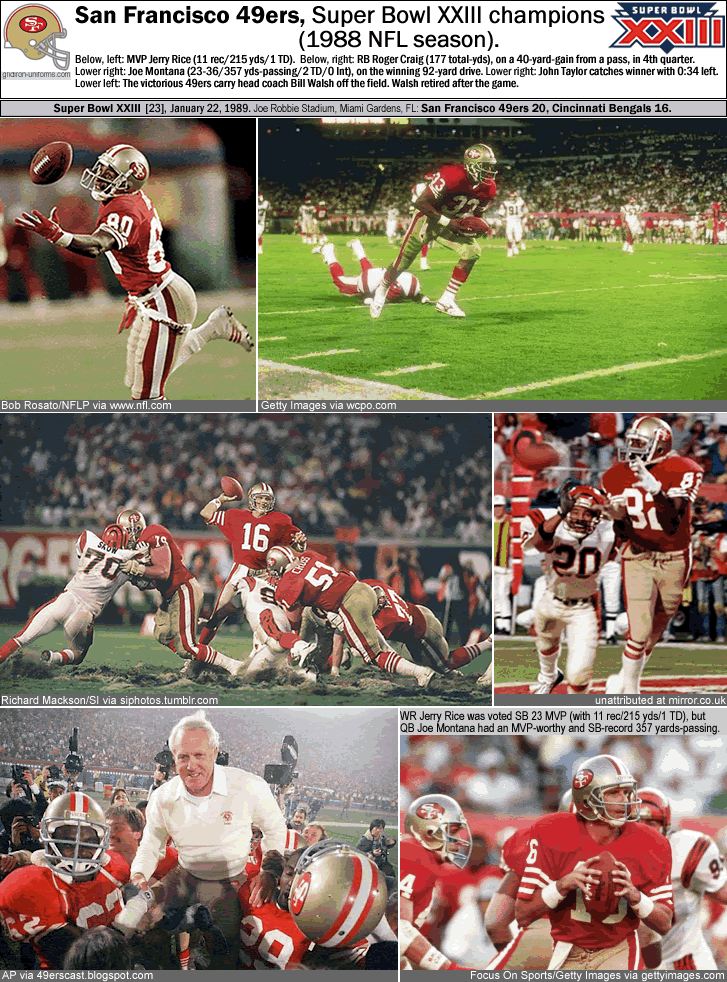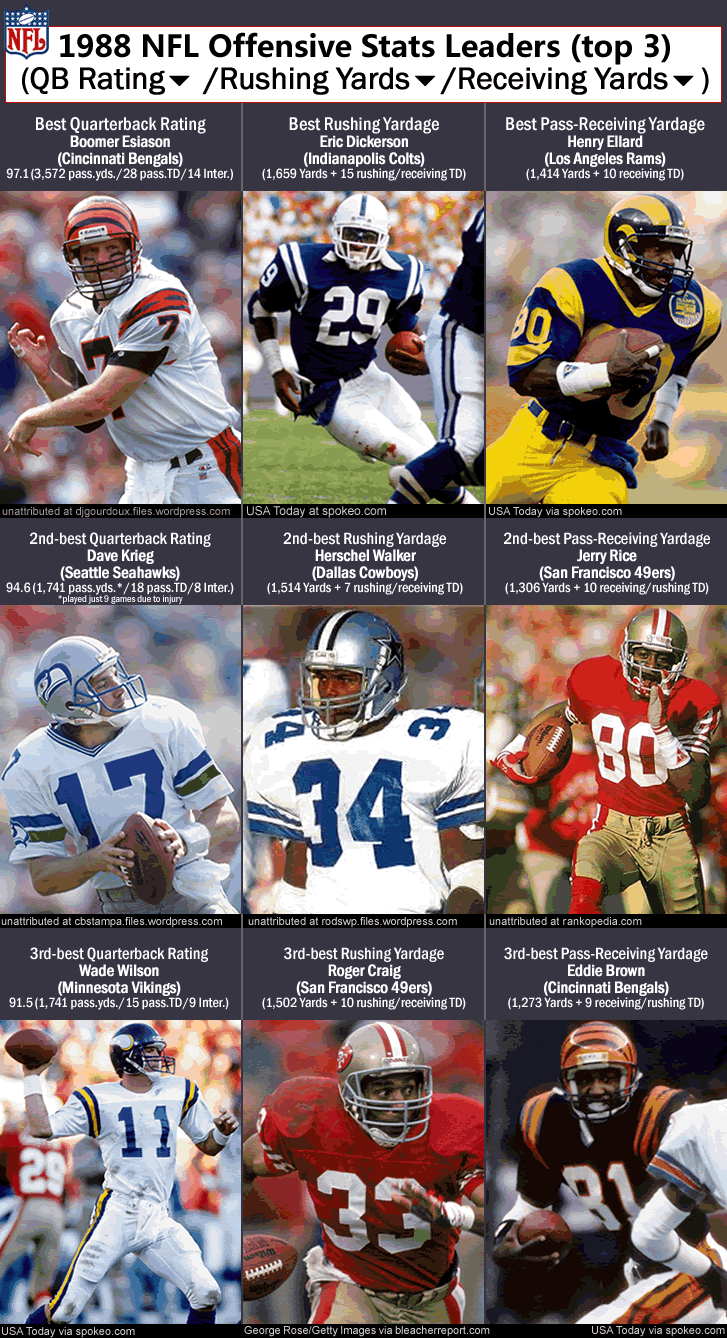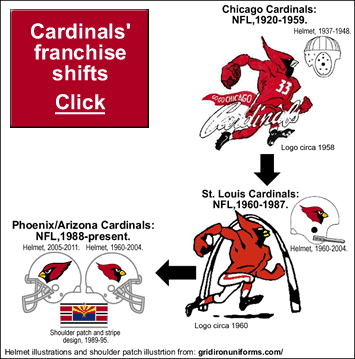
NFL, 1988 season: map with helmets
…
…
-
NFL, 1988…
By Bill Turianski on 18 November 2015; twitter.com/billsportsmaps.com.
The 1988 NFL season & Super Bowl XXIII (23)…
-NFL 1988 standings, etc, here, 1988 NFL_season/Final standings (en.wikipedia.org).
The NFL was coming off a 1987 season which saw a 24-day player-strike that shortened the season by one game [to 15 games]. Reigning champions in 1988 were Washington.
The biggest change in the NFL in 1988 was, of course, the franchise shift that saw the NFL’s oldest team – the Cardinals – move from St. Louis, Missouri to Greater Phoenix, Arizona {see the short article at the foot of this post}. The Cardinals remained in the [NFC] East Division (finishing 7-9). (The Cardinals became part of the re-vamped NFC West in 2002.)
The playoff races in the NFL in 1988 were very tight in several divisions, with a 3-way/10-6 tie for first place in the NFC West going to the San Francisco 49ers, via the tiebreakers; and with a 2-way/10-6 tie for first place in the NFC East going to the Philadelphia Eagles, also via the tiebreakers. (The New Orleans Saints and the New York Giants both went 10-6, yet failed to make it to the postseason.) And in the AFC West, the Seattle Seahawks won their last 2 games to eke out a divisional title (by going 9-7). To round out the playoff teams, in the AFC, along with Seattle, it was Buffalo, Cincinnati, Cleveland (wild-card), and Houston (wild-card). In the NFC, along with San Francisco and Philly, it was Chicago, Minnesota (wild-card), and the LA Rams (wild-card).
Cincinnati and Buffalo shared the best record in the AFC at 12-4, and the two would meet in the AFC Championship game, with QB (and 1988 NFL MVP) Boomer Esiason leading the Bengals over Jim Kelly’s Bills, 21-10. In the NFC, the Bears had the best record at 12-4, with their divisional rival the Minnesota Vikings posting the second-best record in the conference as an 11-5 wild-card team. In the NFC Championship game, the Bears fell 28-3 to the 49ers. San Francisco (who went 10-6) were led on offense by then-10-year-veteran Joe Montana (QB, and 2000 HoF inductee), third-year WR Jerry Rice (a 2010 HoF inductee), and then-6-year-veteran and 1988 Offensive Player of the Year-winner Roger Craig (RB). And the 49ers featured an effective-yet-actually-only-8th-best defense, spearheaded by DE/LB Charles Haley (in his third year then, and a 2015 HoF inductee) and DB Ronnie Lott (a then-8th-year-veteran, and a 2000 HoF inductee).
Head coach Bill Walsh’s San Francisco 49ers might only have had the 8th-best Defense in 1988, and the Niners might have only had the 7th-best Offense in ’88, but their championship caliber was quite evident when they coasted through the playoffs (beating the Vikes 34-9, and then the Bears 28-3). So in Super Bowl XXIII (23), in Miami, on January 22, 1989, San Francisco faced Cincinnati, in a re-match of Super Bowl XVI, which had been played seven years earlier in 1982. Once again, San Francisco beat the Bengals, this time by the score of 20-16. Here is an excerpt from Super Bowl XXIII (en.wikipedia.org)…”The game is best remembered for the 49ers’ fourth-quarter game-winning drive. Down 16–13, San Francisco got the ball on their own eight-yard line with 3:10 on the clock and marched 92 yards down the field in under three minutes. They then scored the winning touchdown on a Joe Montana pass to John Taylor with just 34 seconds left in the game.”
Super Bowl XXIII (23): San Francisco 49ers 20, Cincinnati Bengals 16…

Photo and Image credits above -
Jerry Rice, one-handed-grab from 1st quarter, photo by Lennox McLendon/AP via timelines.latimes.com/nfl-super-bowl-timeline-history. Roger Craig with 40-yard gain to start 4th quarter, photo by Getty Images via wcpo.com/sports/sports-photo-gallery/a-look-back-at-the-bengals-last-super-bowl-25-years-later. Montana in the pocket, set to throw in the 4th quarter on the 92-yard game-winning drive, photo by Richard Mackson/SI via siphotos.tumblr.com. John Taylor catching the winning pass with 34 seconds left, photo unattributed at mirror.co.uk. Bill Walsh being carried off the field by players, photo by AP via 49erscast.blogspot.com/2012/07/Bill Walsh: Noviembre 30, 1931 – Julio 30, 2007. Joe Montana, photo by Focus On Sports/Getty Images via gettyimages.com.
This was the 49ers’ 3rd Super Bowl title
This was the 49ers’ 3rd Super Bowl title. Bill Walsh retired after the win, and the pioneering offensive strategist (the father of the West Coast Offense) was inducted into the Pro Football HoF in 1993. Under new head coach George Seifert, the Niners would repeat as champions the following season [1989]. The 49ers currently [2015] have won 5 Super Bowl titles, which is second only to the Pittsburgh Steelers’ 6 Super Bowl titles, and puts them tied with the Dallas Cowboys for the second-most Super Bowl titles {see this, List of Super Bowl champions/Super Bowl appearances by team (en.wikipedia.org).
…
1988 NFL Offensive Leaders (Regular season, top 3 of: QB Rating, Rushing-Yards, Receiving-Yards)…
[Note: you can click on image below to see it in a separate page.]

Photo and Image credits above -
QBs:
Boomer Esiason (Cincinnati), photo unattributed at djgourdoux.files.wordpress.com; Dave Krieg (Seattle), photo unattributed at cbstampa.files.wordpress.com; Wade Wilson (Minnesota), photo by USA Today via spokeo.com.
RBs:
Eric Dickerson (Indianapolis), photo by USA Today via spokeo.com; Herschel Walker (Dallas), photo unattributed at rodswp.files.wordpress.com; Roger Craig (San Francisco), photo by George Rose/Getty Image via bleacherreport.com.
WRs:
Henry Ellard, photo by USA Today via spokeo.com. Jerry Rice, photo unattributed at rankopedia.com; Eddie Brown (Cincinnati), photo by USA Today via spokeo.com.
…
A brief history of the oldest team in the NFL – the Cardinals, who moved to Arizona in 1988…
The Cardinals (est. 1918 as the Racine Cardinals [of Racine Street in Chicago]), were a founding member of the NFL [APFA] in 1920, when they were located on the South Side of Chicago. A year later, in 1921, Chicago had another pro football team, with the arrival of the Decatur Staleys/Chicago Staleys/Chicago Bears’ franchise (who played on the North Side of Chicago at Wrigley Field). This permanently hobbled the Cardinals. The presence of the Bears in the Windy City ensured that the under-capitalized and poorer-half-of-Chicago-based Cardinals were always playing second fiddle, with a fraction of the media attention and eventually a fraction of the fan support that the Bears enjoyed. It sure didn’t help that the Staleys [Bears], upon arrival in Chicago, were winners…the Chicago Staleys were voted the 1921 APFA title-winners [the title was disputed by the Buffalo All-Americans, who were tied with the Chicago Staleys in the 1921 APFA final standings, and should have been voted co-champions/ see this, 1921 NFL Championship controversy (en.wikipedia.org)].
Meanwhile, the Cardinals were a competitive team in the 1920s, but were a basement-dweller all through the 1930s, and in fact through most of their 40 years in Chicago. In the pre-Super Bowl era of the NFL (1920-65), the Cardinals were the second worst of any team [formed before 1960], with one disputed title (in 1925/ title disputed by the Pottsville Maroons), and one outright title (in 1947, over the Philadelphia Eagles). Back in the first 46 years of the NFL, only the then-title-less Pittsburgh Pirates/Steelers were a worse NFL team than the Chicago/St. Louis Cardinals.
By the late 1950s, it was inevitable that the Chicago Cardinals would have to move the franchise to survive, and after “trying out” Minneapolis/St. Paul, Minnesota as a potential franchise-site in 1959 (when they played their last two home games in Bloomington, MN [at the future home of the Minnesota Vikings and the MLB's Twins]), the Cardinals franchise moved to St. Louis in 1960. The NFL was actually very satisfied with this franchise-shift, and only too happy to see the Cardinals leave Chicago, because it helped block the brand-new rival-league the AFL (of 1960-69) from trying to place a team in St. Louis.
Right upon moving to St. Louis, the Cardinals debuted their stunning white-with-large-frowning-Cardinal-head helmet {see illustrations below; also see this, 1960 St. Louis Cardinals [helmets & uniforms] (gridiron-uniforms.com)}. In their 28 years in St. Louis, the St. Louis football Cardinals played at the same venues as the St. Louis baseball Cardinals – first in Sportsman’s Park, then, from 1966 to 1987 at the multi-purpose concrete doughnut that was Busch Memorial Stadium (II). Under the 15-year-long leadership of QB Jim Hart, and later in the mid-1970s, led by the innovative offensive tactician and head coach Don Coryell, the St. Louis football Cardinals were often a very competitive team, with three 9-win seasons in the mid-1960s, and three 10-or-11-win-seasons in the mid-1970s. But they either folded in the playoffs, or just came short of qualifying for the playoffs. The St. Louis football Cardinals were hampered by playing in very tough divisions (stuck with the NY Giants and Cleveland and Philadelphia in the 1960s, and stuck with Dallas and Washington in the 1970s). The Cardinals failed to make the playoffs despite posting a winning percentage above .600 on six different occasions (in 1963, in 1964, in 1966, in 1968, in 1970, and in 1976). The Cards did make the playoffs in 1974 and ’75, losing in the first round both times.
The Cardinals’ stadium situation deteriorated as the 1980s wore on, and when it became obvious that there was no solution in sight and that the city of St. Louis was refusing to build or co-fund a stadium for the football team, the owners – the Bidwill family – decided it was time to move on again. In Chicago, the Cardinals were ignored because of the Bears; in St. Louis, despite a solid-and-fervent-fanbase, they wore out their welcome. Attendance was dwindling, but that was perhaps thanks to the team perpetually coming up short, and because of the rightfully-enduring popularity of the baseball Cardinals. But it also was because of the fact that the essentially-absentee-owner Bill Bidwill did various things which resulted in alienating much of the fanbase. The team was continually at the bottom of the payroll scale in the league, and the Bidwill family acted like aloof lords who refused to deign the fan-base-rabble with so much as an acknowledgement-of-their-existence. That would not change in the early days of the franchise’s tenure in Phoenix, where Bidwill price-gouged NFL-starved Arizonans, with league-high ticket prices. In 1988 and into the early 1990s, the Phoenix Cardinals under the Bidwill family were charging the highest average-ticket price in the NFL, for an inferior product, in a bad venue. (It was supposed to be a temporary situation at Sun Devil Stadium for the Cardinals, but the Savings and Loan Crisis of the late 1980s derailed any progress on a new venue, and the team was stuck playing in that decrepit stadium for 18 years.)
[Below, old-content-disclaimer: the images below first appeared here, NFL, NFC West: map, with brief team and league history, and titles list.]
Arizona Cardinals Helmet History -

Arizona Cardinals Helmet History
Image credits above – gridiron-uniforms.com/cardinals.
…

Above: Helmet illustrations and shoulder patch illustration from: gridiron-uniforms.com/
The Cardinals in the state of Arizona have actually never played in the city of Phoenix – for their first 18 seasons (1988 to 2005), the Phoenix Cardinals played in nearby Tempe, AZ at Arizona State’s Sun Devil Stadium. (Tempe, AZ is adjacent to, and is just east of, Phoenix.) The Cardinals changed their name to the Arizona Cardinals in 1994. Then in 2006, they moved to another suburb [9 miles NW of downtown Phoenix] – Glendale, AZ, and into the futuristic movable-roofed University of Phoenix Stadium (cap. 68,000-to-78,000), which was site of Super Bowl XLIX (49) in Feb. 2015. The best season the Phoenix/Arizona Cardinals have had was in 2008, when, led by an aging-but-still-effective QB Kurt Warmer and by WR Larry Fitzgerald, the 9-7 Cards caught fire in the playoffs and secured the franchises’ first trip to the Super Bowl. But in Super Bowl XLIII (43) on Feb.1 2009, at Raymond James Stadium in Tampa, FL, the Cardinals came just short of glory, in a thrilling 27-23 loss to the Pittsburgh Steelers.
___
Thanks to Wapcaplet & Angr, for the blank map of USA, at File:Map of USA without state names.svg (commons.wikimedia.org).
Thanks to the now-defunct misterhabs.com/Helmets, aka Helmets, Helmets, Helmets site. At that site I got most of the helmet illustrations on the 1988 map; some helmet illustrations I found at each team’s page at en.wikipedia.org… ‘National Football League‘.
Thanks to MG’s Helmets, for the helmet illustrations of the 2 Super Bowl teams (Cincinnati & San Francisco).
Thanks to Pro-football-reference.com, at 1988 NFL Leaders and Leaderboards.
Thanks to Gridiron Uniform Database, for allowing billsportsmaps.com use of their NFL uniforms illustrations.
Thanks to the contributors at 1988 NFL season (en.wikipedia.org).
